Why do people get cut off by the tide at Wells?
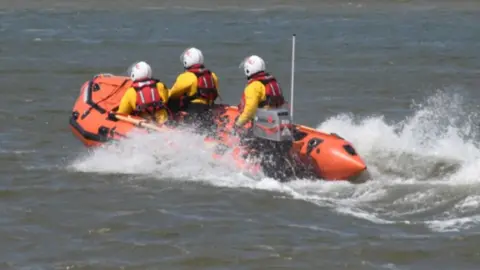 RNLI/Ray West
RNLI/Ray WestA lifeboat service which came to the aid of a young boy on live television has said it has rescued more people cut off by the tide in the past six months than it has in the past seven years. Last week it was called out after 40 people were cut off at two locations on the Norfolk coastline in the space of two hours. Why is the tide so dangerous and what can you do if you get stranded?
With heatwaves arriving, the RNLI crew at Wells-next-the-Sea, in Norfolk, has seen hordes of people visit the beach early in the summer season.
Despite signs and sirens at the beach, Mandy Humphreys, the water safety officer at Wells RNLI, said a lot of people have a lack of knowledge about the tides.
Her warning came as a TV viewers witnessed a 13-year-old boy become stranded live on air at Wells-next-the-Sea.
People watching Look East on Friday evening were able to look on in real time as the beach-goer was loaded on to a lifeboat and brought ashore.
Impact of a changing seabed

Ms Humphreys said the contours of the seabed were "always changing" which leads to people being cut off by the tide, even if they have visited that beach before.
"This is a natural phenomenon. The seabed in this area is very sandy.
"Unfortunately, over the last couple of years a sandbar has been forming and gradually growing, which runs parallel to Wells beach. The drain that separates it from the rest of the beach is getting deeper."
A sandbar is a submerged area of sand or sediment which is formed by waves and currents offshore from a beach.
The one formed at Wells is said to have one steep side and the other having a shallow gradient.
Ms Humphreys said she has been involved in rescues where people did not realise they had been cut off.
"The beach is very alluring. It's absolutely beautiful... there are a significant number of people that we rescue that don't understand the basics about tides."
Tides and times vary
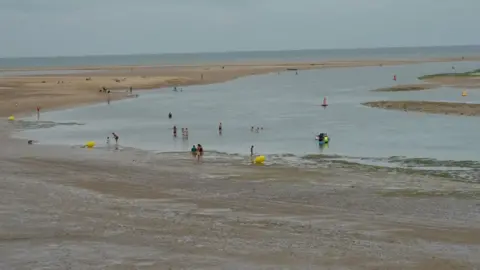 Qays Najm/BBC
Qays Najm/BBCTide times and heights vary throughout the year and can be affected by a number of factors, including the spring equinox, which Ms Humphreys said brings bigger tides than people expect.
She added that rising sea levels also have an impact and the RNLI can be called out all year round by people cut off by the tide.
A tidal surge in March made a "big tide even bigger" and left three people stranded on an area of marshland north of Stiffkey marsh.
They were found "waist deep in water" in an area where the RNLI has not had to rescue people before.
Even locals are vulnerable
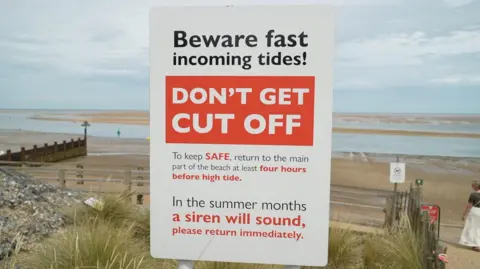 Qays Najm/BBC
Qays Najm/BBCIt is not just beachgoers who have found themselves in troubled waters.
As the seabed and sand is ever changing, people living locally and those who have visited the beach on multiple occasions can never be sure of the conditions.
As one of the hotspots where people become stranded, the RNLI was first alerted to the sandbar at the beach after a group of local residents became unknowingly stuck.
During her time with the RNLI Ms Humphreys has taken part in a simulation of what it is like to be stranded on a sandbar, and despite wearing a life jacket and having a crew near by she said she was left feeling "incredibly vulnerable".
She added: "I've helped rescue people from that sandbar and being stood on that sandbar myself... I still felt quite vulnerable and the urge to wade back to safety is a very strong one, I really understand that now."
Be aware of the dangers
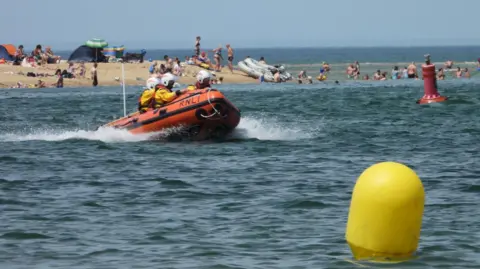 RNLI/Ray West
RNLI/Ray WestMs Humphreys said people visiting the beach often have a lower perception of danger when on holiday.
So far this year 43 people have been rescued by the Wells crew after being stranded, with 34 of them at Wells beach.
"I've been on rescues where we have gone out... the water has been up to my thigh, and then sometimes if there are dogs or children that are frightened it takes some minutes to get them in, and then it [the water] is up to my waist."
Having worked with Wells RNLI for the past seven years, Ms Humphreys said it can take crew members up to 10 minutes to get to an incident after being paged.
One of the worst things is they do not always know the exact details of the incident they are going out to.
"The Stiffkey shout, where we had three shouts on Mothering Sunday, we knew they were up to their waists in water… as a crew member that puts the fear of God into me. Every second really does matter.
"That's real pressure. So we encourage people that if they are cut off, the earlier they can tell us, the longer we have to get there before they are up to their waists in water."
What to do in an emergency
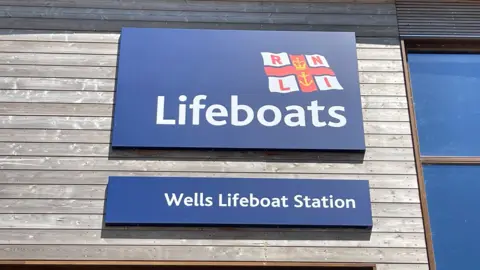 Edd Smith/BBC
Edd Smith/BBCIf you are stranded at the beach, the RNLI urges people to call 999 for help and use what3words to help the service locate them.
It is advised people get back to dry sand at least four hours before high tide.
Ms Humphreys said: "If they sit tight and wait for the lifeboat to get there, that's the safest thing to do.
"For Wells station in particular, we know from the description where they are."
Even though people may want to wade through the water, the steep side of the sandbar means people can find themselves in deep water "quicker than expected".
"It's not the people who call 999 that worry me so much, it's the people who wade back to safety themselves. We get reports of parents holding children above their heads and I worry that if someone loses their footing, you then have a youngster and an adult in the water."
The RNLI's Float to Live campaign advises people that if they find themselves in difficulty they should tilt their head back in the water, try to breath normally, and move their arms and legs to help stay afloat.
Follow Norfolk news on BBC Sounds, Facebook, Instagram and X.
